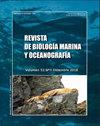墨西哥Veracruzano渔场系统海参资源现状
IF 0.1
4区 生物学
Q4 MARINE & FRESHWATER BIOLOGY
引用次数: 1
摘要
在报告海参存在的地方,通过浮潜和潜水对十个研究区(国家渔业研究所以前研究中建立的样本库)进行了评估。按路线对海参进行了普查和收集,以测量和称重,并记录了它们的栖息地特征。分析了Arrecifal Veracrusano系统中总共138个站点,相当于在北部和南部采集的37794平方米的珊瑚礁面积。在短短25个采样点中,发现了佛罗里达海参(与海草和沙生境有关,深0-1.5米,总长平均10.88厘米,鲜重平均64.09克)和巴迪奥托海参(与沙和活珊瑚生境有关,深1.5-15米,总长平均27.2厘米,鲜重769.19克)。被评估的总银行的平均密度为0.008 ind.m-2。结果表明,萨瓦的海参种群支离破碎(斑块或聚集地),不容易被剥削(单位面积个人密度低)。作为一项管理措施,一些银行被建议作为主要存在海参的潜在地点,目的是监测这些地区并评估人口密度。这项研究及其结果提供了关于海参捕捞潜力的现状,因此,在未来,这将有助于研究它们的文化,以便在该地区可持续利用这一海洋资源。通过自由和自主潜水,对10个研究区域(国家渔业研究所-INAPESCA先前研究中建立的样本库)进行了评估,在这些区域记录了海参的存在。使用带状横断面方法,对黄瓜进行了普查和收集,然后对其进行测量和称重。还记录了栖息地的特征。共分析了138个台站,相当于在夏季系统(SAV)北部和南部地区的珊瑚礁中取样的37794平方米的面积。在只有25个季节中,发现了佛罗里达海参(与海草和沙子栖息地相关,深度为0-1.5米,平均总长度为10.88厘米,平均鲜重为64.09克)和巴迪奥托海参(与沙子和活珊瑚栖息地相关,深度为1.5至15米,平均总长度为27.2厘米,平均鲜重为769.19克)。银行总数的平均密度为0.008 ind.m-2。结果表明,SAV中的海参种群支离破碎(分布在斑块或聚集地),不易开发(单位面积密度低)。作为一项管理措施,建议将一些银行作为海参存在最多的潜在地点,以监测这些地区并评估人口密度。这项研究展示了海参渔业潜力的现状,以便将来研究其自然繁殖作物,从而可持续利用该地区的这一资源本文章由计算机程序翻译,如有差异,请以英文原文为准。
Situación actual del recurso pepino de mar en el Sistema Arrecifal Veracruzano, México
EnglishThroughout snorkeling and scuba diving ten study zones (sampling banks established in previous research by Instituto Nacional de Pesca - INAPESCA) were evaluated where the presence of the sea cucumber was reported. By line transect sea cucumbers were censed and collected to be measured and weighed, as well as their habitat characteristics were recorded. A total of 138 stations in the Sistema Arrecifal Veracruzano (SAV), equivalent to 37.794 m² of reef area sampled in the north and south were analyzed. In just 25 sampling points there were found Holothuria floridana (associated to seagrass and sand habitat, 0-1.5 m deep, with total length average of 10.88 cm and fresh weight average of 64.09 g) and Isostichopus badionotus (associated to sand and live coral habitat, 1.5-15 m deep, total length average of 27.2 cm and fresh weight of 769.19 g). The average density of the total banks evaluated was 0.008 ind.m-2. Results indicate that sea cucumber population in SAV is fragmented (patchiness or aggregation sites) and is not susceptible of exploitation (low density of individuals per unit area). As a management measure, some banks were suggested as potential sites in which there was a major presence of sea cucumber, with the purpose of monitoring these areas and evaluate the density of the population. This research and its results offer a current status about the fishing potential of the sea cucumber so that in the future, it will allow the suggestion to investigate their culture for the natural repopulation for a sustainable use of this marine resource in the region. EnglishSe evaluaron 10 zonas de estudio (bancos de muestreo establecidos en investigaciones previas por el Instituto Nacional de Pesca - INAPESCA) mediante buceo libre y autonomo, donde se registro la presencia de pepino de mar. Usando el metodo de transecto en banda, se censaron y recolectaron los pepinos para luego medirlos y pesarlos. Se registraron ademas las caracteristicas del habitat. Se analizaron un total de 138 estaciones equivalentes a 37.794 m² de area muestreada en arrecifes de la zona norte y sur del Sistema Arrecifal Veracruzano (SAV). En solo 25 estaciones se encontro pepino de mar de las especies Holothuria floridana (asociada al habitat de pastos marinos y arena, a profundidades de 0-1,5 m, longitud total promedio de 10,88 cm y peso fresco promedio de 64,09 g) e Isostichopus badionotus (asociada al habitat de arena y corales vivos, profundidades de 1,5 a 15 m, longitud total promedio de 27,2 cm y peso fresco promedio de 769,19 g). La densidad promedio en el total de los bancos fue de 0,008 ind.m-2. Los resultados indican que la poblacion de pepino de mar en el SAV se encuentra fragmentada (distribucion en parches o sitios de agregacion) y no es susceptible a explotacion (baja densidad por unidad de area). Como una medida de manejo, se proponen algunos bancos como sitios potenciales en los cuales hubo mayor presencia de pepino de mar, con la finalidad de monitorear estas areas y evaluar la densidad de la poblacion. Esta investigacion muestra el panorama actual acerca del potencial pesquero del pepino de mar para que en el futuro, se investigue su cultivo para repoblamiento natural, permitiendo un aprovechamiento sustentable de este recurso en la region
求助全文
通过发布文献求助,成功后即可免费获取论文全文。
去求助
来源期刊
CiteScore
0.70
自引率
0.00%
发文量
41
审稿时长
12 months
期刊介绍:
Publicar desde una perspectiva científica, artículos originales, decididos por un proceso de revisión por pares, invitando a expertos de reconocido prestigio en el área. Los trabajos publicados se caracterizarán por su solidez teórica-metodológica, actualidad y relevancia para las ciencias marinas.
Se reciben trabajos inéditos derivados de la investigación científica realizada en ambientes marinos y estuarios, en formato de Revisión, Artículos, Notas Científicas, y Obituarios en las siguientes disciplinas::
Biología-Ecología marina
Oceanografía física, química y biológica
Contaminación marina
Geología marina
Sistemática, Faunística y Biogeografía Marina
Manejo Costero
Acuicultura marina
Pesquería marina.

 求助内容:
求助内容: 应助结果提醒方式:
应助结果提醒方式:


